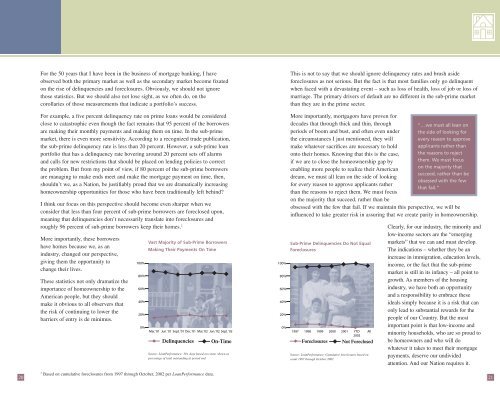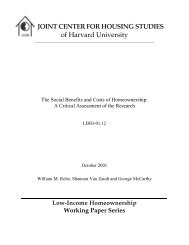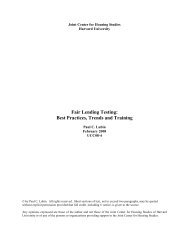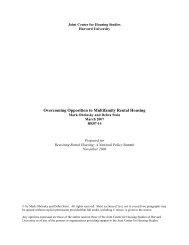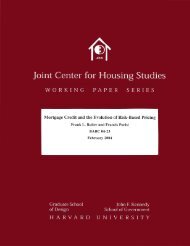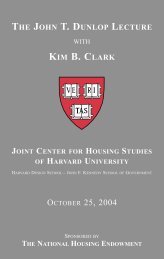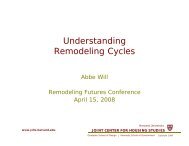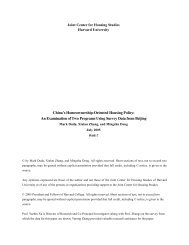The American Dream of Homeownership: From Cliché to Mission
The American Dream of Homeownership: From Cliché to Mission
The American Dream of Homeownership: From Cliché to Mission
You also want an ePaper? Increase the reach of your titles
YUMPU automatically turns print PDFs into web optimized ePapers that Google loves.
10<br />
When it comes <strong>to</strong> credit, there is a double-edge, as well. On one side is the fact that<br />
lenders are difficult <strong>to</strong> access because mainstream and reputable financial<br />
institutions are not always conveniently located near potential low-income and<br />
minority homebuyers. On the other side is the fact that many potential low-income<br />
and minority homeowners have questionable credit his<strong>to</strong>ries – at least as measured<br />
by the standard underwriting models available <strong>to</strong>day – or no measurable credit<br />
his<strong>to</strong>ry at all. Thus, even if they can access a lender, that lender can’t or won’t help.<br />
“One <strong>of</strong> the more obvious<br />
resolutions <strong>to</strong> the Money Gap<br />
is the elimination <strong>of</strong> down<br />
payment requirements for<br />
low income and minority<br />
borrowers.”<br />
A report done for the Local Initiatives Support<br />
Corporation, otherwise known as LISC, found that over<br />
40 percent <strong>of</strong> African <strong>American</strong> renters whose income<br />
was under $40,000 did not have banking relationships <strong>of</strong><br />
any kind. If these families want <strong>to</strong> become homeowners,<br />
they are <strong>of</strong>ten rejected by traditional lenders in the loan<br />
process; and if that is the case, they frequently become<br />
easy prey for preda<strong>to</strong>ry and unscrupulous lenders.<br />
One <strong>of</strong> the more obvious resolutions <strong>to</strong> the Money Gap is the elimination <strong>of</strong> down<br />
payment requirements for low-income and minority borrowers. Current down<br />
payment requirements <strong>of</strong> 10 percent or less add absolutely no value <strong>to</strong> the quality<br />
<strong>of</strong> the loan. It is the willingness and the ability <strong>of</strong> a borrower <strong>to</strong> make monthly<br />
payments that are the determinants <strong>of</strong> loan quality.<br />
Over the past 50 years, I have personally interviewed thousands <strong>of</strong> potential<br />
homebuyers and in the vast majority <strong>of</strong> cases, the barrier standing in between them<br />
and the house <strong>of</strong> their dreams was the down payment. That barrier must be<br />
eliminated by <strong>of</strong>fering cus<strong>to</strong>mized programs <strong>to</strong> those borrowers who cannot meet<br />
the current down payment requirements.<br />
That brings me <strong>to</strong> the second issue that contributes <strong>to</strong> the overall homeownership<br />
gap – namely, the Education Gap.<br />
<strong>The</strong>re is a truth in our industry that determining who<br />
gets a mortgage and at what interest rate is <strong>of</strong>ten<br />
more an art than it is a science. Put another way –<br />
understanding the home-buying process can be<br />
complicated and confusing, especially for lowincome<br />
and minority families. Not only are there<br />
dozens <strong>of</strong> documents <strong>to</strong> review and sign, but there are<br />
income ratios and a variety <strong>of</strong> loan options that a borrower must wade through. In<br />
addition, borrowers are faced with the complexity <strong>of</strong> understanding credit scores,<br />
commonly known as FICO, and the issue <strong>of</strong> how <strong>to</strong> improve these scores and ensure<br />
that the data contained by the credit reposi<strong>to</strong>ries is accurate.<br />
We must make the process not just easier, but easier <strong>to</strong> comprehend. We must get<br />
information <strong>to</strong> potential homeowners in a manner and language that they can<br />
understand. We must educate the low-income and minority sec<strong>to</strong>r about their rights<br />
and the responsibilities <strong>of</strong> homeownership. Equally important, we must reduce the<br />
documentation required <strong>to</strong> make any and all loans; we should be able <strong>to</strong> approve<br />
loans in minutes, rather than days, and close loans in days, rather than weeks.<br />
Furthermore, we should streamline the title insurance process and we should<br />
replace the public recording <strong>of</strong> documents with book entry as is done with s<strong>to</strong>cks<br />
and bonds. This will substantially reduce costs and improve affordability.<br />
If we fail <strong>to</strong> seek paradigms <strong>to</strong> simplify the process, accelerate the timing and<br />
reduce the cost <strong>of</strong> obtaining a mortgage, we will be left with two scenarios. One is<br />
that potential buyers will be <strong>to</strong>o intimidated by the very process <strong>of</strong> buying a home<br />
<strong>to</strong> even attempt <strong>to</strong> move forward. <strong>The</strong> other is that for those who do have the<br />
fortitude <strong>to</strong> proceed, they can easily fall prey <strong>to</strong> the slick marketing schemes <strong>of</strong><br />
preda<strong>to</strong>ry lenders promising an effortless process. All <strong>of</strong> the technology is in place<br />
<strong>to</strong>day <strong>to</strong> both simplify and accelerate the process and the only issue standing in the<br />
way <strong>of</strong> change, unfortunately, is the “fear” <strong>of</strong> change.<br />
<strong>The</strong> final gap I’d like <strong>to</strong> talk about is what I will call the Housing Gap. What I<br />
mean by the Housing Gap is that there is just not enough affordable and decent<br />
housing. Part <strong>of</strong> that may be a cruel irony <strong>of</strong><br />
the fact that our industry remains one <strong>of</strong> the<br />
economy’s only steady and strong<br />
performers. And because <strong>of</strong> the continuing<br />
high demand for housing and the limited<br />
supply, home values continue <strong>to</strong> rise,<br />
thereby making homeownership less<br />
affordable.<br />
But because increasing homeownership<br />
opportunities increases national<br />
economic growth, we must also realize<br />
that there are other contributing fac<strong>to</strong>rs<br />
<strong>to</strong> the high cost <strong>of</strong> housing. <strong>The</strong>y include<br />
government regulations, egregious<br />
regula<strong>to</strong>ry fees, outdated building codes,<br />
and a plethora <strong>of</strong> restrictions on land use.<br />
Education Gap: <strong>The</strong> Solution<br />
• Make process easier & more<br />
understandable<br />
• Provide information in<br />
different languages<br />
• Education on rights &<br />
responsibilities<br />
• Reduce documentation<br />
required<br />
• Speed approval process<br />
• Streamline title insurance<br />
process<br />
11


